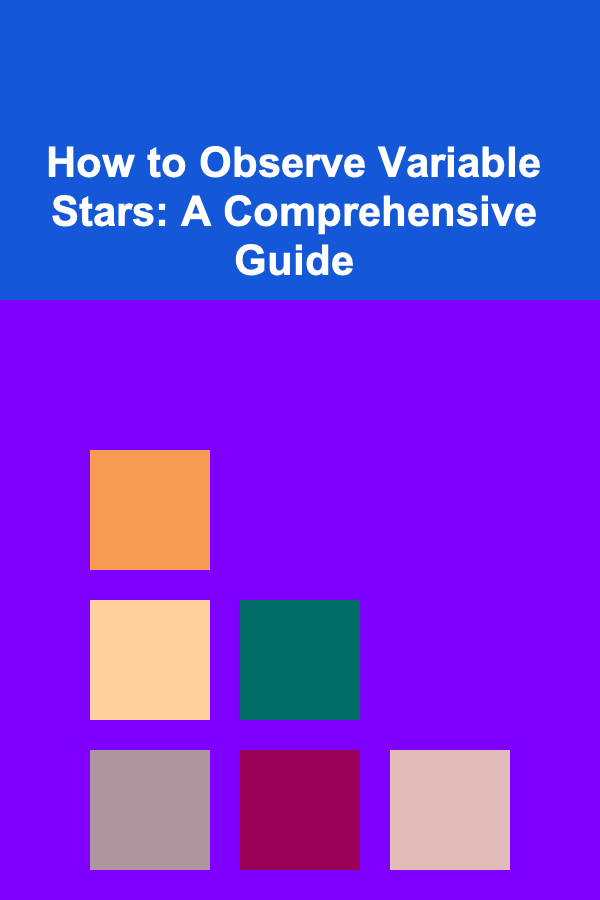
How to Observe Variable Stars: A Comprehensive Guide
ebook include PDF & Audio bundle (Micro Guide)
$12.99$10.99
Limited Time Offer! Order within the next:

Variable star observing is a fascinating and rewarding pursuit for amateur astronomers of all skill levels. Unlike observing static celestial objects like planets or galaxies, observing variable stars involves tracking their changing brightness over time, providing a direct connection to the dynamic processes occurring within these distant suns. This comprehensive guide will walk you through everything you need to know, from understanding what variable stars are to acquiring and analyzing your own observational data.
What are Variable Stars?
Variable stars are stars whose apparent magnitude (brightness) as seen from Earth changes over time. This variation can be caused by a variety of factors, both intrinsic and extrinsic.
Intrinsic Variable Stars
Intrinsic variable stars experience changes in brightness due to physical processes occurring within the star itself. These are generally divided into several categories:
-
Pulsating Variables: These stars expand and contract periodically, causing changes in their temperature and radius, which in turn affects their luminosity. Important types include:
-
Cepheid Variables: These are luminous giant stars with periods ranging from a few days to several weeks. Their period is directly related to their luminosity (the Period-Luminosity relation), making them crucial "standard candles" for measuring distances in the universe.
-
RR Lyrae Variables: These are older, less massive stars than Cepheids, with periods typically less than a day. They are commonly found in globular clusters and are used to determine distances within our galaxy.
-
Mira Variables: These are red giants with long periods (typically hundreds of days) and large amplitude variations. They are often associated with mass loss and late stages of stellar evolution.
-
-
Eruptive Variables: These stars experience sudden and dramatic increases in brightness due to explosive events. Types include:
-
Novae: These are binary systems where a white dwarf star accretes matter from a companion star. When enough material accumulates, a thermonuclear runaway occurs on the white dwarf's surface, causing a sudden brightening. Novae return to their pre-outburst brightness over time.
-
Supernovae: These are much more energetic events than novae, resulting from the catastrophic collapse of a massive star (Type II, Ib, Ic) or the thermonuclear detonation of a white dwarf (Type Ia). Supernovae are extremely bright and can outshine entire galaxies.
-
Dwarf Novae: These are a type of cataclysmic variable, specifically a binary system where a white dwarf accretes matter from a companion star through an accretion disk. Dwarf novae exhibit smaller, more frequent outbursts than classical novae.
-
Extrinsic Variable Stars
Extrinsic variable stars change in brightness not due to internal processes, but due to external factors, often involving another star or object.
- Eclipsing Binaries: These are binary star systems where one star periodically passes in front of the other, causing a dip in the total observed brightness. The shape and duration of the light curve (a plot of brightness vs. time) provide information about the sizes, temperatures, and orbital parameters of the stars.
- Rotating Variables: These stars have uneven surface brightness distributions, often caused by starspots. As the star rotates, the observed brightness changes.
Why Observe Variable Stars?
There are many compelling reasons to engage in variable star observing:
- Scientific Contribution: Amateur observations are valuable to professional astronomers. Large-scale surveys often have gaps in their temporal coverage, and amateur data can fill these gaps, providing crucial long-term monitoring of variable stars. Organizations like the American Association of Variable Star Observers (AAVSO) collect and disseminate these observations to researchers worldwide.
- Hands-on Learning: Observing variable stars is a great way to learn about stellar evolution, binary star systems, and astronomical measurement techniques. It allows you to directly apply theoretical concepts to real-world data.
- Accessibility: Variable star observing can be done with relatively simple equipment, from binoculars to small telescopes. It's an accessible hobby for anyone with an interest in astronomy.
- The Thrill of Discovery: While discovering a completely new variable star is rare, you might catch a known variable star in an unusual state or contribute to a better understanding of its behavior.
Getting Started: Equipment and Resources
You don't need expensive equipment to begin observing variable stars. Here's a breakdown of what you'll need:
Essential Equipment
- Star Charts or Software: You'll need a way to locate the variable stars you want to observe. Star charts (either printed or digital) are essential. Software like Stellarium (free and open source) or commercially available planetarium programs can be extremely helpful.
- Magnitude Sequences: These are charts that show the variable star and nearby "comparison stars" with known magnitudes. You'll use these comparison stars to estimate the magnitude of the variable star. The AAVSO provides magnitude sequences for many variable stars.
- Notebook and Pencil: For recording your observations and making notes about sky conditions and any difficulties you encounter.
- Red Flashlight: To preserve your night vision while reading charts and recording data.
- Binoculars or Telescope: Binoculars are a great way to start, especially for brighter variable stars. A small telescope (60mm or larger) will allow you to observe fainter stars.
Optional but Recommended Equipment
- Camera and Software for CCD or DSLR Photometry: For more precise magnitude estimates, especially of fainter stars. A dedicated CCD camera is ideal, but a DSLR camera can also be used with appropriate software.
- Computer or Tablet: For accessing star charts, magnitude sequences, and recording data in a digital format.
Essential Resources
-
The American Association of Variable Star Observers (AAVSO): The AAVSO is the premier organization for variable star observers. Their website (aavso.org) provides a wealth of information, including:
-
Variable Star Index (VSX): A comprehensive catalog of known variable stars.
-
Magnitude Sequences: Downloadable charts with comparison star magnitudes.
-
Observing Manuals and Tutorials: Detailed guides on different observing techniques.
-
Observation Submission Tools: Software and web forms for submitting your observations.
-
-
Books on Variable Stars: Many books cover the topic of variable stars, providing background information on their classification, behavior, and observing techniques. Look for titles specifically geared toward amateur astronomers.
-
Online Forums and Communities: Connect with other variable star observers online. Forums and mailing lists can provide a valuable source of information, advice, and support.
Choosing Your Targets
With thousands of variable stars to choose from, it's important to select targets that are appropriate for your equipment and observing conditions. Here are some factors to consider:
- Brightness: Start with brighter variable stars that are easily visible in your binoculars or telescope. As you gain experience, you can move on to fainter targets.
- Variability Type: Different types of variable stars have different periods and amplitudes. Choose stars with periods that are compatible with your observing schedule. Eclipsing binaries, for example, may require frequent observations over a relatively short period.
- Location: Select stars that are well-placed in the sky from your location at the time you plan to observe. Stars near the horizon will be more affected by atmospheric extinction.
- Magnitude Range: Consider the magnitude range of the variable star. Make sure that the faintest magnitude it reaches is still within the reach of your equipment.
- AAVSO Target List: The AAVSO publishes target lists with priorities based on current research needs. Observing these stars will provide the most valuable data for professional astronomers.
Some good starting points for beginners include:
- Delta Cephei: A classic Cepheid variable, easily visible with binoculars. Its period is approximately 5.4 days.
- R Leonis: A bright Mira variable with a period of about 310 days and a large amplitude variation.
- Algol (Beta Persei): A famous eclipsing binary with a distinctive light curve. Its period is approximately 2.87 days.
Observing Techniques: Visual Estimation
Visual estimation is the most basic method of variable star observing. It involves comparing the brightness of the variable star to the brightness of nearby comparison stars with known magnitudes.
- Locate the Variable Star: Use your star chart or software to find the variable star in the sky. Take your time and make sure you're looking at the correct star field.
- Identify Comparison Stars: Using the AAVSO magnitude sequence for the variable star, identify several comparison stars that are slightly brighter and slightly fainter than the variable star. It's best to choose comparison stars that are as close as possible in color to the variable star.
- Estimate the Magnitude: Carefully compare the brightness of the variable star to the comparison stars. Try to interpolate between the comparison star magnitudes to estimate the magnitude of the variable star. For example, if the variable star appears to be halfway in brightness between a comparison star with magnitude 7.0 and another with magnitude 7.5, you would estimate the variable star's magnitude to be 7.25.
- Record Your Observation: Record the date, time (in Universal Time or UTC), the estimated magnitude of the variable star, the comparison stars you used, the instrument you used (binoculars or telescope, and its aperture), and your observing conditions (seeing, transparency). Also, note any problems you encountered during the observation.
Here's an example of a typical visual observation record:
Date: 2023-10-27
Time (UTC): 03:15
Variable Star: Delta Cephei
Magnitude Estimate: 4.1
Comparison Stars: A = 3.8, B = 4.5 (Delta Cephei appears slightly fainter than A)
Instrument: 10x50 Binoculars
Seeing: Good
Transparency: Good
Notes: No issues.
Tips for Visual Estimation
- Use Averted Vision: Sometimes, looking slightly to the side of the star (averted vision) can help you see fainter objects or better discern subtle differences in brightness.
- Take Your Time: Don't rush your observations. Spend a few minutes carefully comparing the brightness of the variable star to the comparison stars.
- Practice Regularly: The more you observe, the better you'll become at estimating magnitudes.
- Be Consistent: Use the same comparison stars whenever possible, and try to observe under similar sky conditions.
- Estimate in Tenths of Magnitudes: Try to estimate the magnitude to the nearest tenth of a magnitude (e.g., 7.1, 7.2, 7.3). This increases the precision of your observations.
Observing Techniques: CCD and DSLR Photometry
CCD (Charge-Coupled Device) and DSLR (Digital Single-Lens Reflex) photometry offer a more precise and objective way to measure the brightness of variable stars. This method involves taking digital images of the star field and using software to measure the amount of light received from the variable star and comparison stars.
Equipment for CCD/DSLR Photometry
-
Telescope: A telescope with a stable mount is essential for accurate photometry. The larger the aperture, the fainter the stars you can measure.
-
CCD Camera or DSLR: A CCD camera is specifically designed for astronomical imaging and offers better sensitivity and dynamic range than a DSLR. However, a DSLR can be a good starting point. For DSLRs, it's important to use RAW image format to preserve the maximum amount of data.
-
Filters: Using filters (e.g., Johnson-Cousins B, V, R, I filters) allows you to measure the brightness of stars in specific wavelength ranges, providing information about their temperature and color. While not strictly essential for getting started, they will be necessary for producing scientifically valuable data.
-
Mount: An equatorial mount is almost a must have for longer exposures. An Alt-Az mount with field derotation capabilities is a possible alternative.
-
Computer and Software: You'll need a computer to control the camera, take images, and process the data. Popular software packages include:
-
Maxim DL: A comprehensive software package for image acquisition, processing, and photometry (commercial).
-
AstroImageJ: A powerful and free image processing and photometry tool written in Java.
-
IRAF: A powerful and free astronomical data processing package (requires some command-line experience).
-
Siril: Free and Open Source software dedicated to astrophotography image processing.
-
CCD/DSLR Photometry Procedure
- Image Acquisition: Take a series of images of the variable star field. Use appropriate exposure times to ensure that the variable star and comparison stars are well-exposed but not saturated. Take multiple exposures to allow for stacking and averaging, which reduces noise. Also, take calibration frames (dark frames, bias frames, and flat frames) to correct for various instrumental effects.
- Image Calibration: Use your image processing software to calibrate the images by subtracting dark frames and bias frames, and dividing by flat frames. This will remove systematic errors from the images.
- Image Alignment and Stacking: Align the calibrated images to compensate for any telescope drift or atmospheric distortions. Stack the aligned images to improve the signal-to-noise ratio.
- Aperture Photometry: Use your photometry software to measure the brightness of the variable star and comparison stars. Select appropriate apertures (circular regions) around each star and measure the total flux (light) within each aperture. Subtract the sky background from each measurement.
- Differential Photometry: Calculate the difference in magnitude between the variable star and the comparison stars. This technique helps to cancel out any atmospheric effects or instrumental variations that affect all stars in the field equally.
- Transform to Standard Magnitudes: If you are using filters, you may need to transform your instrumental magnitudes to standard magnitudes (e.g., Johnson-Cousins magnitudes) using transformation equations derived from observations of standard stars.
- Error Analysis: Estimate the uncertainty in your magnitude measurements. This can be done by analyzing the scatter in your data or by using error propagation techniques.
- Record Your Observation: Record the date, time (UTC), the measured magnitude of the variable star, the comparison stars you used, the instrument you used (telescope aperture, camera type, filter), the exposure time, and the software you used. Also, note any problems you encountered during the observation.
Tips for CCD/DSLR Photometry
- Take Plenty of Calibration Frames: Accurate calibration is essential for obtaining high-quality photometric data. Take a sufficient number of dark frames, bias frames, and flat frames.
- Avoid Saturated Stars: Saturated stars will not provide accurate magnitude measurements. Adjust your exposure times to avoid saturation.
- Use Good Focusing: Accurate focusing is crucial for obtaining sharp images and precise photometry. Use a Bahtinov mask or other focusing aid.
- Choose Appropriate Aperture Sizes: The aperture size should be large enough to capture most of the light from the star but small enough to minimize the contribution from the sky background. A typical aperture size is 2-3 times the full width at half maximum (FWHM) of the star image.
- Track Accurately: Precise tracking is essential for longer exposures. Guiding is often necessary to achieve accurate tracking.
Submitting Your Observations
Once you have acquired and analyzed your observations, you can submit them to the AAVSO or other organizations that collect variable star data. Submitting your observations is a valuable contribution to science and helps to improve our understanding of variable stars.
-
Register with the AAVSO: If you haven't already, register as an observer on the AAVSO website (aavso.org).
-
Use the AAVSO WebObs Tool or VPhot: The AAVSO provides online tools for submitting observations. WebObs is a web-based form for entering visual observations. VPhot is the AAVSO's cloud-based image processing and photometry platform designed to streamline the submission of photometric data. The VPhot platofrm helps you to calibrate, analyze, and submit your observations to the AAVSO's international database
-
Follow the AAVSO Submission Guidelines: The AAVSO has specific guidelines for formatting and submitting observations. Be sure to follow these guidelines carefully to ensure that your data is accepted.
-
Be Patient: It may take some time for your observations to be processed and added to the AAVSO database.
Analyzing Your Data
Once you have a collection of observations, you can analyze them to learn more about the variable star's behavior. Some common analysis techniques include:
- Creating Light Curves: A light curve is a plot of the variable star's magnitude versus time. Light curves can reveal the period, amplitude, and shape of the star's variations.
- Determining Periods: You can use various period-finding algorithms (e.g., the Lomb-Scargle periodogram) to determine the period of the variable star's variations.
- Phase Plotting: A phase plot is a light curve where the time axis is expressed in terms of the phase of the star's period. Phase plots can reveal details about the shape of the light curve and can be used to compare observations taken at different times.
- Comparing to Models: Compare your observations to theoretical models of variable stars to learn more about the physical processes that are causing the star's variations.
Software for analyzing variable star data includes:
- VStar: An AAVSO-developed software package specifically designed for analyzing variable star data. It allows you to create light curves, determine periods, and perform other analysis tasks.
- Period04: A program for time series analysis, particularly useful for period determination.
- Excel or Other Spreadsheet Software: Can be used for basic data plotting and analysis.
Conclusion
Observing variable stars is a rewarding and engaging activity that can be enjoyed by amateur astronomers of all skill levels. By following the steps outlined in this guide, you can start making your own observations, contributing to scientific research, and learning more about the fascinating world of variable stars. So grab your binoculars or telescope, find a dark sky, and begin your journey into the dynamic universe of variable stars!

How to Build a Content Promotion Checklist for Content Syndication
Read More
How to Maintain Your Home's Outdoor Lighting Fixtures
Read More
How to Set Up a Checklist for Image and Media Optimization
Read More
How to Use a Whiteboard for Weekly Meal Planning
Read More
How to Use Amazon Advertising to Promote Your Custom Products
Read More
How to Use Technology for Remote Property Management
Read MoreOther Products

How to Build a Content Promotion Checklist for Content Syndication
Read More
How to Maintain Your Home's Outdoor Lighting Fixtures
Read More
How to Set Up a Checklist for Image and Media Optimization
Read More
How to Use a Whiteboard for Weekly Meal Planning
Read More
How to Use Amazon Advertising to Promote Your Custom Products
Read More